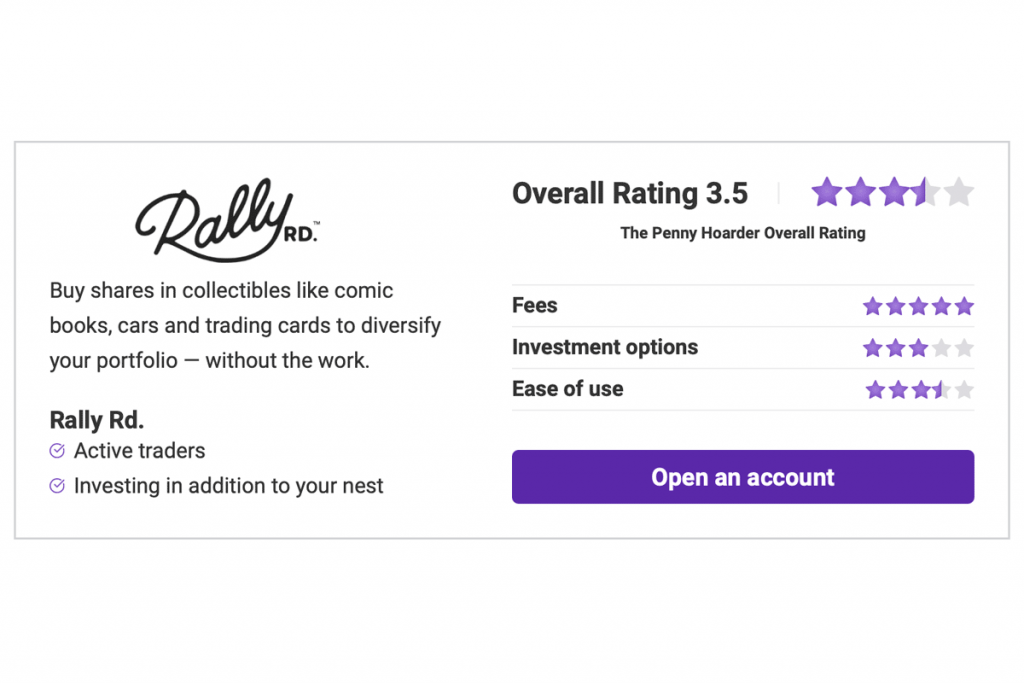Ever wanted to cash in on nostalgia?
Vintage and cultural collectibles have long been a pastime and earning opportunity for hobbyists and folks with quirky interests and cash to spare. In recent years, collectibles have become an attractive asset class for creative investors, as well.
But it’s always been a tough market to break into — collectibles tend to be pricy to acquire because of the resources needed to find and store them, on top of their high asking prices.
Now anyone can take advantage of alternative investments through an app called Rally Rd., which lets you buy and sell shares of everything from Pokemon cards to Ford Mustangs to even shares of a first edition 1940 DC Comics Batman comic book. These days, the app is going by just Rally, though Rally Rd. is the official name.
Rally Rd. Investment App
Best for Active Traders
Key Features
- Commission-free alternative investing
- Buy shares of collectible assets and NFTs
- Live secondary trading
Rally is an app that lets you buy shares in alternative assets like comic books, cars, trading cards and other collectibles. Through the app, you can browse collections and see each asset’s value, share price and number of shares, plus specs about what makes it valuable. You can invest with no commissions and no hidden fees, then sell shares or buy more through registered brokers.
Rally Rd. Investment App
Opening an account
$0
When assets can be resold
Five days after purchase
Fees
No commissions or fees
Trading times
Monday through Friday, excluding standard stock market holidays, from 10:30 a.m. to 4:30 p.m. eastern time.
What Is the Rally Investment App?
Rally is a platform for the web, iOS and Android that lets you buy and sell equity shares of collectible items, including sports memorabilia, books, comics, classic cars, NFTs — even Pokemon cards.
Launched in 2016 as Rally Rd., the app initially focused on buying and selling equity shares in classic cars and has since expanded to offer collectibles from wine to guitars.
Buying and trading collectibles is a way to add diversity to your investment portfolio and operate outside of the fluctuations of public stock exchanges. By trading equity shares through an app like Rally, you may be able to tap into this market with significantly less risk, because investments are SEC-regulated and you don’t have to put up as much money to get started.
Collectibles tend to act differently than the stock market, so they’re attractive for active investors during times of market volatility, inflation or recession. However, collectibles — by definition — tend to be rare or one-of-a-kind assets, so it’s difficult to determine trends in their value and safely predict whether they’ll make or lose money.
How Does Rally Work?
Rally acquires collectible assets and makes them available for investors and traders through the app.
You don’t have to scour auctions to nab rare finds or fork over thousands of dollars to own valuable collectibles. Rally handles sourcing, authentication and acquisition from collections around the world. It securitizes the assets and splits them into equity shares, so you can incorporate these collectibles into your portfolio for just a few dollars a share.
You can also sell your shares to other buyers through live trading in the app by making them available with partner broker-dealers. Other buyers can place bids, and the app’s algorithm matches your offer with the best deal to sell your share.
Rally occasionally sells assets, and you’ll get paid for your shares if that happens. But, in general, Rally holds onto assets for the long term, and your best way to make money through the app is through live trading.
Your investments through Rally are funded by a connected bank account, and you can withdraw earnings into the same account anytime.
3 Steps to Investing With Rally
- Create an account through the iOS or Android app or online.
- Invest in an asset during its initial offering and/or make bids on the secondary market.
- List your shares for sale as “ASKs” to be matched with buyers.
Rally requires active trading, so it’s not a good fit if you’re looking for an automated or passive investment app. It doesn’t include options to automate deposits or investments, so this isn’t a set-it-and-forget-it platform for your long-term savings.
How Rally Invests Your Money
Rally sources assets poised to rise in value by considering rarity, significance, history, originality, value, condition and other data-driven factors. It doesn’t lean on any single aesthetic but instead purchases a variety of collectibles to offer assets that’ll appeal to various tastes and financial goals.
Through the app, you’re in control of where your money goes and when to buy or sell assets.
You can invest in an assets initial offering or make bids to purchase shares on the secondary market 90 days or more after an initial offering. You don’t have to wait for Rally to sell an asset; you can cash in or reduce your exposure anytime by listing your shares for sale through an ask.
Rally Fees
Rally doesn’t charge commissions on trades or management fees on your holdings in the app. Instead, it makes money by taking a sourcing fee that’s included in an asset’s initial offering price — which means no additional fees for you. You’ll be aware of the sourcing fee for any offering you invest in, but you won’t pay a fee on top of your investment price.
Rally Customer Service
You can contact Rally anytime via email at [email protected] or via text at 347-952-8058. You might also get your questions answered by browsing the platform’s FAQ page.
Pros and Cons
Pros
- Diversify your portfolio with alternative investments in collectibles.
- Benefit from valuable collectibles without the huge upfront cost or work.
- No commissions on trades or account management fees.
Cons
- No automated investment opportunities.
- The company doesn’t sell assets; you earn primarily through active trading.
- Investing in real assets comes with inherent risk.
Frequently Asked Questions (FAQs) About Rally
There are a lot of questions about this interesting investment app and we’ve got the answers to the most commonly asked questions.
Is Rally Rd. a Good Investment?
Rally lets you invest in collectible assets, from classic cars to trading cards. The company doesn’t make any claims about returns you can expect by trading on the app, and investing in real assets comes with unique risks you won’t face in the stock market. However, it can add diversity to your portfolio and reduce your exposure to the volatility of the stock market during times of recession or inflation that could hurt traditional investments.
Rally is an investment platform where you can buy, sell and trade equity shares of collectible assets, like classic cars, wine, trading cards and comic books. The company’s purpose is to source collectibles and facilitate trading by securitizing and splitting assets into equity shares you can buy and sell on its platform. It carries similar risk to any collectible investing, but you can mitigate risk by spreading your investments across assets instead of betting a lot on a single item.
Can You Make Money on the Rally App?
Investing of any kind comes with the possibility of earning money and the risk of losing money. Rally facilitates trading so you can invest in initial offerings of collectible assets and sell or buy more on the secondary market through the platform. You earn money by selling shares worth more than you paid for them; Rally doesn’t typically liquidate assets in the short term.
How Do You Trade on Rally?
In the app, you can buy and sell shares of collectibles that Rally has acquired. Anyone can purchase shares during an asset’s initial offering. After 90 days, sellers can make those shares available through “ASKs,” and buyers can place a “BID” for assets they want to purchase. The app matches sellers and buyers and executes sales daily.
Contributor Dana Miranda is a Certified Educator in Personal Finance® who has written about work and money for publications including Forbes, The New York Times, CNBC, Insider, NextAdvisor and Inc. Magazine. Freelancer Larissa Runkle contributed to this report.



